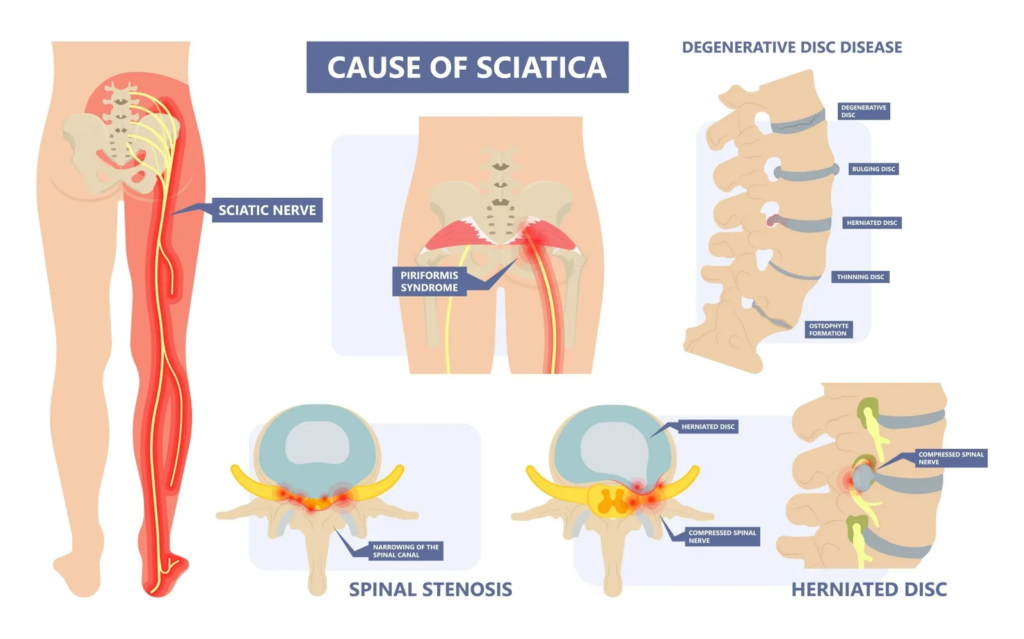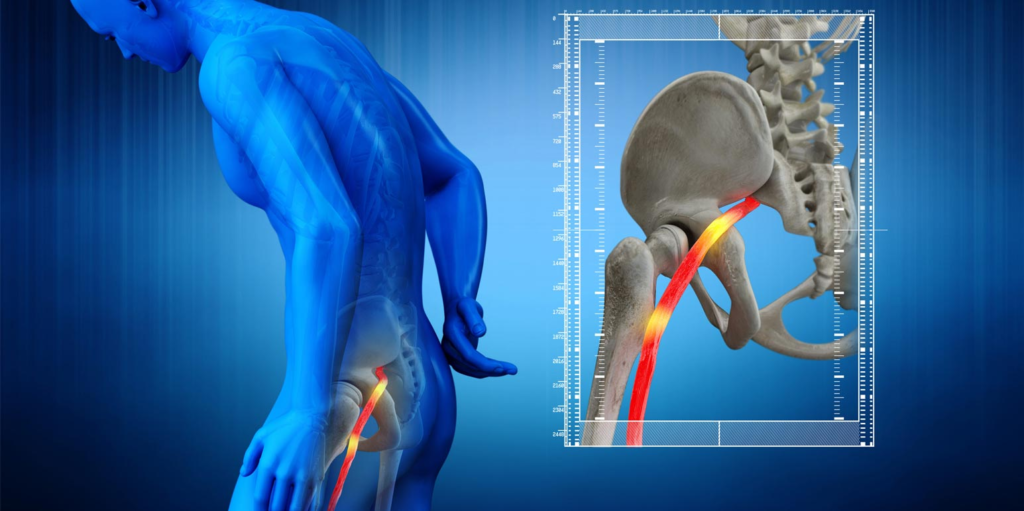Introduction
Signs of Sciatica Improving/Healing, Sciatica is a common condition that affects millions of people worldwide, causing pain, discomfort, and reduced mobility. It occurs when the sciatic nerve, which runs from the lower back down the back of each leg, becomes irritated or compressed. Managing sciatica involves understanding its stages, recognizing signs of improvement, and employing effective strategies for relief. In this comprehensive guide, we will delve into the various aspects of sciatica, exploring its stages, exercises for relief, the role of massage, the best braces for nerve pain, and more.
I. Understanding Sciatica: A Brief Overview
Signs of Sciatica Improvement Signs of Sciatica Improvement, Before diving into the stages and signs of improvement, it’s crucial to understand what sciatica is and its common causes. Sciatica often results from a herniated disc, spinal stenosis, or other conditions that exert pressure on the sciatic nerve. Signs of Sciatica Improvement The symptoms include pain, numbness, and tingling that radiate from the lower back down the leg.
II. The Stages of Sciatica
A. Early Stage: Recognizing the Onset
- Gradual Onset of Pain: Sciatica typically begins with a gradual onset of pain in the lower back or buttocks, which then radiates down one leg. Understanding these initial sensations is vital for early intervention.
- Numbness and Tingling: As the condition progresses, individuals may experience numbness and tingling in the affected leg. These symptoms can be intermittent and may vary in intensity.
B. Intermediate Stage: Intensification of Symptoms
- Sharp Shooting Pain: In the intermediate stage, the pain may become more intense and take on a sharp, shooting quality. This can make daily activities challenging and affect the overall quality of life.
- Increased Nerve Irritation: The sciatic nerve may become more irritated during this stage, leading to heightened discomfort. Identifying these signs is crucial for implementing targeted interventions.
C. Advanced Stage: Chronic and Severe Symptoms
- Persistent Pain: At the advanced stage, individuals may experience persistent and chronic pain. Signs of Sciatica Improvement This pain can be debilitating and significantly impact mobility and daily activities.
- Limited Range of Motion: Reduced flexibility and a limited range of motion are common in advanced sciatica. This can lead to muscle stiffness and further exacerbate the overall discomfort.

III. Signs of Sciatica Improving/Healing
A. Pain Reduction
- Gradual Diminishment: Improvement often begins with a gradual reduction in pain levels. Individuals may notice that the sharp, shooting pain diminishes over time, allowing for increased comfort.
- Decreased Frequency: The frequency of sciatic pain episodes tends to decrease as the condition improves. Recognizing a reduction in how often pain occurs is a positive sign of recovery.
B. Improved Mobility
- Increased Range of Motion: As the sciatic nerve irritation subsides, individuals may experience improved flexibility and a wider range of motion. This is a key indicator of progress in the recovery process.
- Enhanced Daily Activities: Successful management of sciatica leads to better functionality in daily activities. Signs of Sciatica Improvement Individuals may find it easier to perform tasks that were previously challenging due to pain and discomfort.
C. Resolving Numbness and Tingling
- Gradual Relief: The numbness and tingling associated with sciatica often diminish gradually as the nerve irritation subsides. Recognizing a reduction in these sensations is a positive sign of healing.
- Restoration of Sensation: Improvement in nerve function may lead to the restoration of sensation in the affected leg. This is a crucial aspect of sciatica recovery and indicates nerve healing.
D. Enhanced Sleep Quality
Chronic pain associated with sciatica can disrupt sleep patterns. As the condition improves, individuals may experience better sleep quality, contributing to overall well-being.
IV. Strategies for Sciatica Improvement
A. Sciatica Exercise: A Comprehensive Approach To Healing

- Targeted Stretches: Incorporating specific stretches into a daily routine can help alleviate sciatic pain. A sciatica exercise PDF can provide a comprehensive guide to effective stretches that target the affected areas.
- Strengthening Exercises: Building strength in the muscles that support the spine is crucial for sciatica recovery. Signs of Sciatica Improvement The PDF can include a variety of strengthening exercises designed to promote overall spinal health.
B. The Role of Massage in Sciatica Relief
- Easing Muscle Tension: Massage therapy can help alleviate muscle tension in the lower back and buttocks, providing relief to individuals with sciatica. The gentle manipulation of tissues can contribute to improved comfort.
- Promoting Circulation: Improved blood circulation is essential for the healing process. Massage enhances circulation, ensuring that nutrients and oxygen reach the affected areas, promoting healing.
C. Best Braces for Sciatica Nerve Pain
When exploring options for sciatica braces, individuals should assess their specific needs and preferences. Factors such as the severity of pain, lifestyle, and daily activities can influence the choice of the most suitable brace. Below are some Braces explained:
- Lumbar Support: Braces that provide adequate lumbar support can be beneficial for individuals with sciatica. Proper support helps maintain the natural curvature of the spine, reducing pressure on the sciatic nerve.
- Compression Technology: Some braces utilize compression technology to target specific areas and alleviate nerve pain. Exploring the available options and consulting with a healthcare professional can help individuals find the best brace for their needs.

V. Pros & Cons of Sciatica Treatment:
| Treatment Method | Pros | Cons |
|---|---|---|
| Sciatica Exercises | – Cost-Effective: Most exercises can be done at home without the need for expensive equipment. | – Requires Discipline: Consistent commitment to exercise routines is necessary for effectiveness. |
| – Improves Flexibility: Regular exercises can enhance flexibility, reducing muscle tightness. | – Initial Discomfort: Some exercises may cause initial discomfort for individuals not used to physical activity. | |
| – Strengthens Muscles: Strengthening specific muscle groups can contribute to better spine support. | – May Need Professional Guidance: Guidance from a physical therapist might be necessary, which can incur additional costs. | |
| – Tailored Approach: Exercises can be tailored to individual needs, targeting specific areas of pain. | – Not Instantaneous Relief: Results may take time to manifest, requiring patience. | |
| Massages | – Immediate Relief: Massages can provide immediate relief from muscle tension and pain. | – Cost: Regular massage sessions can become expensive over time. |
| – Relaxation: Massage therapy promotes overall relaxation, reducing stress and tension. | – Temporary Relief: The effects of massage may be temporary, requiring ongoing sessions. | |
| – Complements Other Treatments: Can be used in conjunction with other treatments for enhanced results. | – Not Suitable for All: Some individuals may have conditions that make massages unsuitable. | |
| – Improved Blood Circulation: Massage can improve blood flow, aiding in the healing process. | – Time-Consuming: Regular sessions may take up a significant amount of time. | |
| Sciatica Braces | – Provides Support: Braces offer support to the lower back and pelvis, reducing pressure on the sciatic nerve. | – Dependency: Prolonged use may lead to dependence, weakening natural support muscles. |
| – Adjustable: Many braces are adjustable to provide a customized level of support. | – Discomfort: Some individuals may find braces uncomfortable, especially during extended wear. | |
| – Ease of Use: Simple to incorporate into daily life, providing continuous support. | – Visible Under Clothing: Depending on the type, braces may be visible under clothing. | |
| – Variety of Options: Various types of braces are available to suit different needs and preferences. | – Limited Range of Motion: May restrict movement to some extent. | |
| – Can Aid Recovery: Supports the healing process by minimizing strain on the affected area. | – Cost: Quality braces can be relatively expensive. |
VI. Last Stages of Sciatica: Managing Persistent Symptoms
A. Seeking Professional Guidance
- Consultation with Healthcare Providers: Individuals experiencing persistent sciatic symptoms should seek professional medical advice. Healthcare providers can offer tailored recommendations based on the specific characteristics of the condition.
- Physical Therapy: Physical therapy is often recommended in the last stages of sciatica to address residual symptoms and improve overall strength and flexibility. Therapists can guide individuals through exercises and stretches that promote recovery.
VII. Can Sciatica Cause Knee Pain?
- Understanding the Connection: Knee pain can be a secondary symptom of sciatica. The sciatic nerve’s pathway includes branches that extend to the knee, and irritation of these branches can lead to knee discomfort.
- Addressing Knee Pain: Effective management of sciatica involves addressing not only lower back and leg pain but also associated symptoms like knee pain. Signs of Sciatica Improvement Tailored interventions can target these specific areas.
VIII. Monitoring Progress
- Keeping a Pain Journal: Maintaining a pain journal can help individuals track their sciatica symptoms and monitor progress over time. Regularly documenting pain levels, activities, and any notable changes provides valuable insights into the effectiveness of chosen interventions.
- Patience and Consistency: Recovering from sciatica is often a gradual process, and patience is key. Consistent adherence to recommended exercises, therapies, and lifestyle adjustments contributes to sustained improvement. Understanding that positive changes may take time reinforces a realistic and optimistic mindset.
IX. Lifestyle Modifications

- Ergonomic Considerations: Making ergonomic adjustments in daily life can significantly contribute to sciatica improvement. This includes maintaining proper posture, using ergonomic furniture, and ensuring workstations are conducive to spinal health. These modifications reduce the strain on the lower back, supporting the healing process.
- Weight Management: Excess body weight can exacerbate sciatic symptoms by placing additional pressure on the spine and nerves. Signs of Sciatica Improvement Engaging in a healthy diet and regular exercise to achieve and maintain an optimal weight can alleviate strain on the lower back and facilitate recovery.
X. Comprehensive Approach to Pain Management
- Integrating Holistic Therapies: In addition to conventional medical interventions, individuals may explore holistic approaches to pain management. Techniques such as acupuncture, yoga, and mindfulness-based stress reduction have shown promise in complementing traditional treatments and promoting overall well-being.
- Psychological Support: The impact of chronic pain on mental health should not be underestimated. Signs of Sciatica Improvement Seeking psychological support, such as counseling or therapy, can help individuals cope with the emotional aspects of living with sciatica. Signs of Sciatica Improvement Addressing stress and anxiety can positively influence the perception and management of pain.
XI. Future Prevention Strategies
- Maintaining Spinal Health: Once sciatica symptoms improve, maintaining spinal health becomes crucial for preventing recurrence. This includes regular exercise, proper lifting techniques, and ongoing attention to posture and ergonomics.
- Periodic Check-ups: Even after significant improvement, individuals with a history of sciatica should schedule periodic check-ups with their healthcare providers. Signs of Sciatica Improvement These appointments allow for the early detection of any potential relapse or emerging issues, ensuring timely intervention.
Conclusion
Signs of Sciatica Improvement In conclusion, recognizing the signs of sciatica improvement is crucial for individuals navigating this challenging condition. Understanding the stages of sciatica, implementing targeted exercises, considering the role of massage therapy, choosing the right brace for nerve pain, and seeking professional guidance in the last stages are essential components of a comprehensive approach to sciatica management. Signs of Sciatica Improvement By staying informed and proactive, individuals can embark on a journey toward improved comfort, mobility, and overall well-being.

Read More: Why Is My Dog Biting His Tail? Home Remedies for Dog Biting Tail
FAQs:
1. What are the common signs that sciatica is improving?
Answer: Signs of sciatica improvement include a gradual reduction in pain, decreased frequency of pain episodes, improved mobility, increased range of motion, and the resolution of numbness and tingling sensations. Monitoring these changes over time provides valuable insights into the progression of recovery.
2. Can massage therapy help alleviate sciatica pain?
Answer: Yes, massage therapy can be beneficial for individuals with sciatica. It helps ease muscle tension, promotes better circulation, and contributes to overall relaxation. Incorporating regular massage sessions, along with other recommended treatments, can enhance the effectiveness of a comprehensive sciatica management plan.
3. What exercises are included in a sciatica exercise PDF?
Answer: A sciatica exercise PDF typically includes targeted stretches and strengthening exercises. Stretches focus on improving flexibility while strengthening exercises aim to build the muscles that support the spine. The PDF provides a comprehensive guide with step-by-step instructions to perform these exercises safely and effectively.
4. Is knee pain associated with sciatica, and how can it be addressed?
Answer: Yes, sciatica can cause knee pain as the sciatic nerve branches extend to the knee. Addressing knee pain involves managing the underlying sciatic nerve irritation. Tailored interventions, including exercises and therapies, can target both lower back and knee pain, providing holistic relief.
5. What is the role of a lumbar brace in managing sciatica nerve pain?
Answer: A lumbar brace provides essential support to the lower back, helping maintain the natural curvature of the spine. This support reduces pressure on the sciatic nerve, offering relief from pain and discomfort. When choosing a brace, considering factors such as lumbar support and compression technology can help individuals find the most effective solution for their sciatica management.How do I know if my sciatica is getting better or if I need to seek additional treatment?
6. How do I know if my sciatica is getting better or if I need to seek additional treatment?
- Answer: Signs of sciatica improvement include reduced pain, increased mobility, and improved overall well-being. However, if symptoms persist or worsen, or if new symptoms emerge, it is crucial to consult with a healthcare professional for a thorough evaluation and appropriate guidance.



Pingback: Chiropractic Treatment for Sciatica: 4 Ways to Heal Sciatica